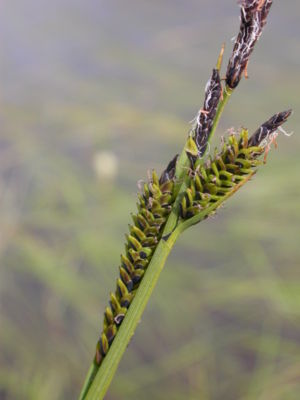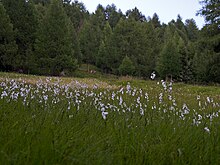Brown sedge
| Brown sedge | ||||||||||||
|---|---|---|---|---|---|---|---|---|---|---|---|---|

Brown sedge ( Carex nigra ) |
||||||||||||
| Systematics | ||||||||||||
|
||||||||||||
| Scientific name | ||||||||||||
| Carex nigra | ||||||||||||
| ( L. ) Reichard |
The brown sedge ( Carex nigra ), also called meadow sedge , is a species of the genus Seggen ( Carex ) within the sour grass family (Cyperaceae). It is widespread in the northern hemisphere . It is common and rich in shape, grows in wet locations and characterizes the Braunseggen swamp societies of the Kleinseggenriede named after it .
description

The brown sedge is a deciduous, perennial, herbaceous plant that reaches heights of 10 to 50, rarely up to 90 centimeters. It forms long underground shoot streamers ( rhizomes ) loose to dense lawn. The base of the stem is rounded and triangular with numerous leafless, brown to reddish brown sheaths. It does not form sterile stems .
The more or less upright, dark gray-green leaves that overhang to the tip are up to 100 centimeters long and 2 to 5 mm wide. They are parallel-edged, flat to slightly creased or V-shaped in cross-section and rough at the edges. The leaf sheaths are triangular, yellow-brown to red-brown, matt or glossy, and often pervaded by fine lattice veins. The mouth of the vagina is always somewhat curved. The anterior vaginal wall is thin-white-skinned, usually lobed disintegrating and with the white, not high continuous Ligule often associated skin like a collar (Ligulae). They become 1 to 3 mm long. The flower stem becomes 5 to 50 centimeters high and about 1 mm thick. It is sharp, triangular, slender, firm, erect or ascending and rough in the upper part. The lowest bract is leaf-like and usually shorter than the inflorescence.
The leaves are epistomatisch, that is, the stomata are located on the upper leaf surface - in contrast to the hypostomatischen Carex acuta (stomata below) and the amphistomatischen bastard Carex acuta (stomata top and bottom).
The inflorescence is erect and contains one to two stalked, dark purple, male and below two to four sessile, black-green, female spikelets . The black husks are keeled green. The fruit sacs (utriculi) are green, domed brown on the outside and flat on the inside. They are longer than the husks and surround the zweinarbigen ovary and later the brown closed fruits .
The number of chromosomes is 2n = 80, 82, 84 or 88.
ecology
The brown sedge is a geophyte in which the persistence organs (rhizomes) lie under the earth's surface. In this way, the plant can outlast unfavorable seasons and sprout again in spring.
The brown sedge is a marsh plant ( helophyte ). As a half-light to full-light plant, it cannot be shaded. It is quickly displaced by taller species in more favorable locations with better nutrient supply.
The flowering period extends from May to June; the fruits ripen from July to August. Pollination occurs by the wind ( anemogamy ). The diaspores spread by wind ( anemochory ), water ( hydrochory ) or by self- propagation ( autochory ).

Occurrence
The brown sedge is widespread in the northern hemisphere in the temperate zones. It occurs in parts of Western Asia , Western Siberia , North Africa, and Atlantic North America . The brown sedge is common in almost all of Europe. In the Allgäu Alps, it rises up to 2100 meters above sea level.
It grows on sub-neutral, mostly lime-poor, nutrient-poor to moderately nutrient-rich soils with pH values between 4.8 and 6.4, but preferably on acidic peat . The focus is on extremely moist to wet, acidic and low-nitrogen soils . It is the character species of the plant communities of the brown sedge swamps (order: Caricetalia nigrae). These are mainly characterized by dark to red or golden brown colored brown mosses ( Amblystegiaceae ). The Kleinseggenriede form larger stands in intermediate bogs or are scattered over small areas in wet meadows , but also come into contact with reed communities of bodies of water or in muddy dune valleys of the islands.
Systematics
While Haeupler et al. In 2000, an intraspecific classification of the species is not considered sensible for Germany, Govaerts (ed.) Names six subspecies:
- Carex nigra subsp. alpina (Gaudin) Lemke : It occurs in the mountains of Central Europe, Southwestern Europe and northwestern Turkey.
- Carex nigra subsp. drukyulensis Noltie : It only occurs in Bhutan .
- Carex nigra subsp. intricata (Tineo) Rivas : It occurs in the Moroccan Atlas Mountains, in the Spanish Sierra Nevada, in Corsica and in Sicily.
- Carex nigra subsp. juncea (Fr.) Soó (Syn .: Carex juncella (Fr.) Th.Fr. ): It is widespread from northern and central Europe to Mongolia.
- Carex nigra subsp. nigra ( Syn .: Carex alboatra Willd. ex Kunth , Carex angustifolia Sm. , Carex antucensis Kunze ex Kunth , Carex aquanigra B.Boivin , Carex compacta Krock. ex Hoppe nom. illeg., Carex Eboracensis Nelmes , Carex fusca All. , Carex gibsonii Bab. , Carex goodenowii J.Gay , Carex intermedia Miègev. , Carex malazena Steud. , Carex melaena Wimm. , Carex melanolepis Phil. , Carex polyandra Schkuhr , Carex rufa Lam. , Carex subcaespitosa (KUek.) Wiinst. , Carex tumida Beilschm. , Carex acuta var. minor Sw. , Carex acuta var. angustifolia Celak. , Carex acuta var. macrocarpa Celak. , Carex acuta var. oxylepis Sanio , Carex acuta var. turfosa Sanio , Carex cespitosa var. curvata F.Fleisch. , Carex cespitosa var. Recta F. Fleisch. , Carex cespitosa var. Polymorpha Laest. , Carex cespitosa var. Goodenowii (J.Gay) Fiori & Paol. , Carex rigida var. Goodenowii (J.Gay) LHBailey , Carex rigida var. strictiformis L.H. Bailey , Carex vulgaris var. tornata Fr. , Carex vulgaris var. atra Peterm. , Carex vulgar is var. chlorostachya Rchb. , Carex vulgaris var. Polygama Rchb. , Carex vulgaris var. Humilior Maly , Carex vulgaris var. Bructeri G.Mey. , Carex vulgaris var. Rigida Blytt , Carex vulgaris var. Teres Boott , Carex vulgaris var. Angustifolia A.Blytt , Carex vulgaris var. Subramosa Meinsh. , Carex vulgaris var. Intermedia Nyman , Carex vulgaris var. Melaena (Wimm.) Nyman , Carex vulgaris var. Tenuis Hartm. ex Lange , Carex vulgaris var. strictiformis L.H.Bailey , Carex vulgaris var. salinoides Kük. , Carex vulgaris var. Sabulosa Meinsh. , Carex vulgaris var. Elatior Holm nom. illeg., Carex vulgaris var. hydrophila Holm , Carex vulgaris var. fuliginosa (A.Braun) Husn. , Carex nigra var. Strictiformis (LHBailey) Fernald , Carex nigra subsp. recta (F. Fleisch.) Rothm. , Carex nigra subsp. tornata (Fr.) Rothm. , Carex nigra var. Recta (F. Fleisch.) Hyl. , Carex nigra var. Stenocarpa (chick.) Soó , Carex nigra subsp. iberica Rivas Mart. ): It occurs from Europe to East Asia and from Canada to the United States.
- Carex nigra subsp. transcaucasica (TVEgorova) Jim.Mejías, GERodr.-Pal., Amini Rad & Martín-Bravo : It occurs from Turkey to Iran.
The brown sedge forms a hybrid with the slim sedge ( Carex acuta ) , the bastard slim sedge ( Carex × elytroides ). In addition, a hybrid between the brown sedge and the broad-leaved stiff sedge ( Carex elata ) is described, namely the bastard stiff sedge ( Carex × turfosa ).
swell
literature
- Jürke Grau , Bruno P. Kremer, Bodo M. Möseler, Gerhard Rambold, Dagmar Triebel: Grasses. Sweet grasses, sour grasses, rushes and grass-like families in Europe (= Steinbach's natural guide . Volume 19 ). Mosaik, Munich 1990, ISBN 3-570-03695-2 .
- R. Kiffmann: Sour grasses, rushes and other grassy plants. Self-published, Aranno / Ti (Switzerland) 1991.
- A. Petersen: The sour grasses. Akademie-Verlag, Berlin 1989, ISBN 3-05-500257-1 .
- Peter W. Ball, AA Reznicek: Carex. In: Flora of North America Editorial Committee (Ed.): Flora of North America North of Mexico . Volume 23: Magnoliophyta: Commelinidae (in part): Cyperaceae . Oxford University Press, New York / Oxford a. a. 2002, ISBN 0-19-515207-7 , pp. 394 (English, online - with illustration and distribution map ).
Individual evidence
- ^ Erich Oberdorfer : Plant-sociological excursion flora for Germany and neighboring areas . With the collaboration of Angelika Schwabe and Theo Müller. 8th, heavily revised and expanded edition. Eugen Ulmer, Stuttgart (Hohenheim) 2001, ISBN 3-8001-3131-5 , pp. 182 .
- ↑ Erhard Dörr, Wolfgang Lippert : Flora of the Allgäu and its surroundings. Volume 1, IHW, Eching 2001, ISBN 3-930167-50-6 , p. 255.
- ^ Henning Haeupler, Thomas Muer: picture atlas of the fern and flowering plants of Germany . Ed .: Federal Agency for Nature Conservation (= The fern and flowering plants of Germany . Volume 2 ). Eugen Ulmer, Stuttgart (Hohenheim) 2000, ISBN 3-8001-3364-4 .
- ↑ a b c d e f Rafaël Govaerts (Ed.): Carex nigra. In: World Checklist of Selected Plant Families (WCSP) - The Board of Trustees of the Royal Botanic Gardens, Kew . Retrieved October 22, 2016.
- ^ AC Jermy, TG Tutin: Sedges of the British Isles. Botanical Society of the British Isles, London 1982, ISBN 0-901158-05-4 .
Web links
- Brown sedge. In: FloraWeb.de.
- Brown sedge . In: BiolFlor, the database of biological-ecological characteristics of the flora of Germany.
- Profile and distribution map for Bavaria . In: Botanical Information Hub of Bavaria .
- Carex nigra (L.) Reichard In: Info Flora , the national data and information center for Swiss flora .
- Distribution in the northern hemisphere from: Eric Hultén, Magnus Fries: Atlas of North European vascular plants. 1986, ISBN 3-87429-263-0 at Den virtuella floran. (swed.)
- Thomas Meyer: Data sheet with identification key and photos at Flora-de: Flora von Deutschland (old name of the website: Flowers in Swabia )
- Data sheet from Schede di Botanica - Flora Italiana .